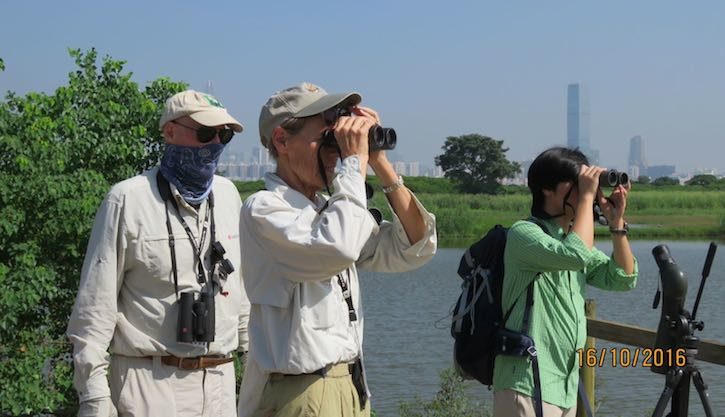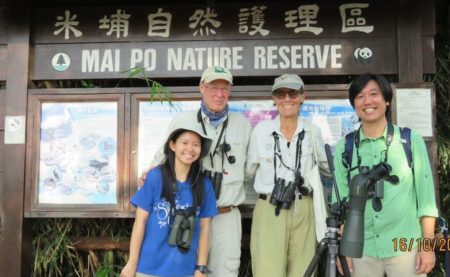
When it comes to birding, Wendy Paulson admits that she has surpassed her husband Hank. True, Hank was into birds before she was. As a young boy, long before his illustrious career at Goldman Sachs and as U.S. Secretary of the Treasury, Hank learned about birds from his father. But when Wendy started learning about birds in her twenties, she was hooked. She has spent a lifetime teaching about birds and conservation in New York and Chicago public schools, as well as running educational bird walks and working to raise awareness of migratory birds and their often dwindling habitats.
On a recent trip to Hong Kong, Wendy and Hank visited the Mai Po and Inner Deep Bay wetlands, a haven for thousands of migratory waterbirds. A standout in wetlands conservation and management, Mai Po, which is managed by WWF, offers training to wetlands conservationists from all across Asia, including managers from China’s Coastal Wetlands Conservation Network, which was established in 2015 with support from the Paulson Institute (founded by Hank). Mai Po, which was named a “Wetland of International Importance” under the Ramsar Convention in 1995, successfully balances protection of wildlife with education and recreation for the local community. Wendy Paulson shares some lessons from Mai Po:
Why do you love Mai Po?

Mai Po is one of the great urban nature sanctuaries in the world. Situated on the coastal mudflats between Hong Kong and Shenzhen and composed largely of mangrove ponds, it is a key stopover and refueling station for millions of shorebirds and waterfowl making their annual flights between the Arctic and Australia/New Zealand, and points in between. I have never visited Hong Kong without going to Mai Po; it offers an extraordinary antidote to the noise, congestion, and hard-surfaced world of Hong Kong proper. Each visit is different. Sometimes it’s the spectacle of thousands of shorebirds foraging in the mudflats as the tide slowly advances. Other times it’s the pleasure of strolling the shaded trails between ponds and ducking into a blind to peer out at the assemblage of birds in the shallows, as well as those soaring overhead or hiding in the marsh vegetation.
One of the things that we find most encouraging is that more and more, we see local visitors with binoculars, cameras, and telescopes. We noted many families on this last trip. Urban reserves like Mai Po are critical for connecting people to nature and helping them understand how the place – their place – is so important in the cycle of life, from the production of fish in the mangroves to the age-old global migration of birds.
You saw or heard 63 different bird species on your recent visit. Any particularly exciting?
Every bird at Mai Po is an important one for us, mostly because we don’t get to see them often! The Bar-Tailed Godwit is certainly a stand-out because of the epic journey—as much as nearly 7000 miles non-stop—it makes every spring and fall. But so is the Red-Whiskered Bulbul, which can be seen even in downtown Hong Kong, and the Yellow Bittern, which reminds us so much of our Least Bittern in the U.S.
The sheer numbers of avian visitors at Mai Po is especially thrilling, and the task of sorting them out a welcome and invigorating challenge. Fortunately, we usually have with us local experts from the Hong Kong Bird Watching Society, such as Vivian Fu and Yu Yat-tung, who help us enormously, both to identify species and to understand the ecology of the site and the conservation challenges and opportunities. We love to learn, and Mai Po is a fertile site for ecological learning.
The Paulson Institute has helped conduct training sessions in Mai Po for mainland wetlands managers. What do you think mainland China can learn from Mai Po?
What impresses us most, and what I think can be shared with others, is the value placed on nature at Mai Po—both valuing the plants and birds and other wild species, and valuing the need for people to understand habitats and the creatures that use them. There is a prevailing tone that nature is really important, and that we humans need to respect that and behave accordingly. That’s a key lesson that Mai Po has to offer both visitors to the site and to others interested in applying it to their own sites elsewhere. There is an attitude of respect throughout—in the blinds/hides that offer viewers comfortable and educational viewing options, while at the same time insisting on proper etiquette both toward wildlife and toward others; in the layout of trails that make exploration easy; in the interpretive signage. There is, we understand, a continuing effort to work with adjacent farmers and landowners to harmonize their needs and practices with those of the preserve, and that is another model to share with others. And it’s great that there is a local NGO – in this case, the Hong Kong Bird Watching Society – that has an active program to offer field outings to the reserve.


